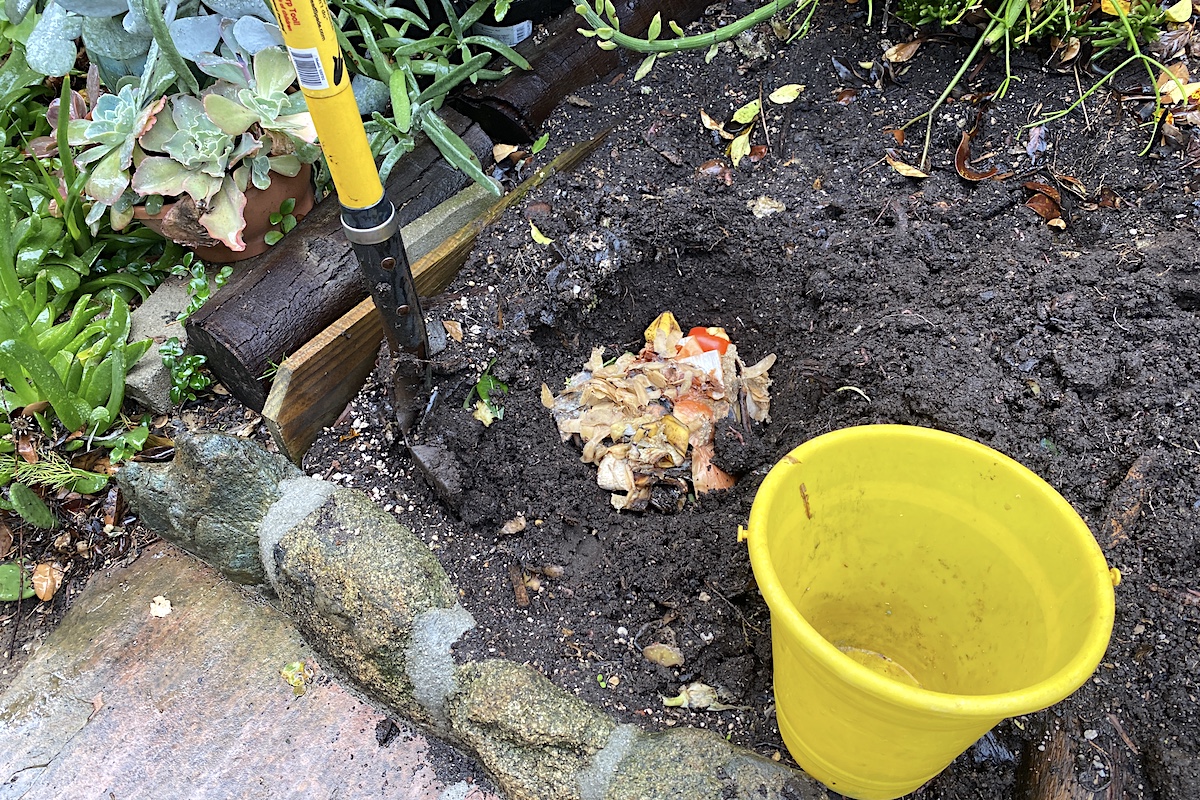
My Easy, Inexpensive In-Ground Compost Method
No bins needed!
The new CA law that requires recycling of kitchen scraps makes sense, but it sure sounds messy and inconvenient. I'll stick with my inexpensive, in-ground compost pile. It's efficient, rewarding and more fun---certainly simpler---than recycling dripping bags of garbage.
I've routinely done the compost method detailed below for decades. The best part: When you top-dress garden beds with finished compost, you're providing perfect food for succulents and other ornamental plants.
For in-ground composting, you'll need:
- Leakproof pail that fits under your kitchen sink. Mine is 8" and plastic.
- Small shovel. I use a "Spearhead" to slice through tree roots.
- Bathtub-sized hole for the compost pile.
- Alfalfa pellets. Provide absorbency, aeration and keep compost crumbly.
- Potting mix. One bag, 1 cubic foot. Any brand.
- Red wigglers (Eisenia fetida). These wee garbage-eaters are different from earthworms.
Note: Amazon links are affiliate and should not imply an endorsement. To save on product costs and shipping, by all means buy local.
It starts under the Sink
In our house, kitchen scraps (peels, vegetables, rinds, coffee grounds, tea bags) go under the sink. Bones and animal protein---whatever might attract vermin---go into the garbage disposal.

Compost pail under the sink
Here's how I trained my family: Whenever someone tossed a banana peel or, say, burnt toast into the trash, I'd say, "Hey! Remember Mr. Compost!" I then retrieved the item and dropped it into the pail. Even our guests "feed Mr. Compost." It's like having a pet under the sink. Burp.
Next go outdoors
Every few days or whenever the pail is full, I escort it to the compost pile. I dig a hole about 12-inches in diameter, dump the contents, and cover with crumbly brown compost. I set the shovel upright in that spot as a marker.
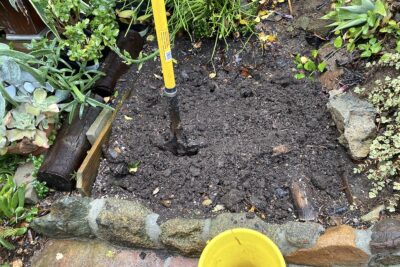
The shovel indicates where new scraps are buried. The entire area is roughly square and dug into a slope.
I dig successive holes for scraps in a clockwise fashion, so I'll know which part of the pile is older (i.e. finished compost) and which is newer (still in process).
Create a dedicated area
The best time to dig your bathtub-sized hole for a compost pile is winter, when the ground is rain-soaked and soft. Make it about 12 inches deep.
Position it near a hose or irrigation riser to help keep compost moist in hot, dry seasons. Also it should be near the kitchen---mine is 30 steps away.
If the compost area is rectangular, you might bury new garbage from, say, left to right.
Make worms comfy
To get your freshly-dug area off to a good start, dump in 5 gallons or so of alfalfa pellets. It's horse chow, available at any tack-and-feed store as well as online.
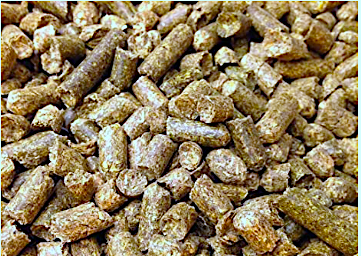
Alfalfa pellets
Soak the pellets so they'll expand (which takes several hours). Then mix in a large bag of inexpensive potting soil. Add a welcome meal of kitchen scraps. Turn the pile to mix everything, then add worms.
Of course it's not compost yet, because it hasn't been through the intestinal tract of a worm. At first the pile will seem small, but remember, you'll continually add to it. Worms increase in number based on the amount of food available, so they're dependent on you. Don't disappoint them!
Won't the hole fill up? Eventually, but those busy little wigglers keep it from getting too big. Composting is condensing. In any case, you can always remove some finished compost (which looks like soil and doesn't have chunks) and spread it throughout the garden.
What could go wrong?
I've read entire books on composting, worried something might go horribly wrong. I honestly don't think it can. Over the years, our hole has flooded, and I've accidentally let it dry out. One summer I neglected to feed "my" worms for weeks. Everything has survived and thrived.
Btw, if garbage under the sink attracts fruit gnats, empty and wash the pail more often, and keep the area around it clean and dry.
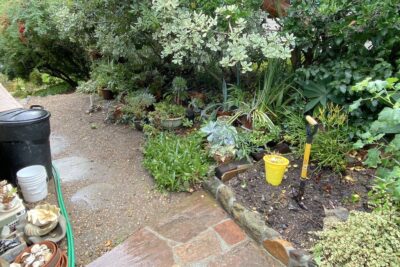
My compost pile is in my garden's potting, utility and nursery area
Like chocolate cake for plants
A major bonus is how compost will benefit the rest of your garden. My back yard once was nutrient-poor dirt consisting of decomposed granite and clay. Over the years, it has turned into soft, crumbly soil that's rich, dark and root-friendly. [See a video of my half-acre garden.]
Btw, alfalfa alone is a great source of nitrogen, potassium and trace minerals.
For years I added chipped and shredded yard waste to the pile, but the advent of green-waste bins has made that unnecessary. I do occasionally add sawdust, dry leaves or soil left over from nursery pots, but they don't seem to make much difference.
Success tips
If you live in a winter-wet, summer-dry climate like mine (inland Southern CA, Zone 9b)...
- Create your compost area in a mostly shady location, so it won't dry out quickly in summer.
- Keep compost moist but not soupy, just wet enough so worms can slip and slide.
- Don't bother trying to compost succulents---they take forever to decompose!
- If your pile functions fine but you don't see worms, they may be in its cool, moist bottom layer.
- When harvesting finished compost, shovel it into plastic nursery pots and set them atop the pile overnight. Worms will descend back into the pile through holes in the bottom of the pots.
- If storms, a broken pipe, a hose-wielding child (or an absent-minded owner) accidentally floods the hole, add alfalfa to absorb excess water. Start with a few handfuls; pellets expand so much, they may overflow the hole. Scatter excess into the garden.
- Turning the pile helps aerate it, which is especially important if you add yard waste. Keep in mind a mixed-waste pile is more work to harvest because it needs sifting.
- Before composting whole fruits or vegs, hack them up. The more surface area a large, dense item has, the quicker worms can process it.
- Don't add weeds that have gone to seed.
- If a seed from a tomato, squash or melon sprouts in the pile, consider it a gift and transplant it into your vegetable garden.
What about odors? And doesn't garbage attract vermin?
There's no smell and no problem with critters unless you add pet waste; or animal fat, bones or protein. I no longer compost eggshells, because a nocturnal visitor---possibly a possum---was digging them out of the pile.
If the pile does smell, it's probably too wet, causing anaerobic decomposition. Aerate it with alfalfa and/or dry, chopped yard waste.
Isn't a compost pile unsightly?
No. In fact, I make a point of showing it to visitors. If they're interested, I dig up a knot of worms, and ask if they've ever held any. (Worms tickle.) A fond memory is of two teen-age boys who backed away in horror. (Clearly they weren't raised right.)
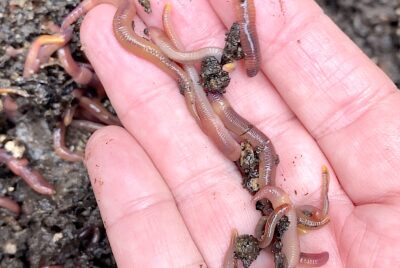
It's not necessary to pet your worms, but it IS nice to name them.
My grown son enjoys discussing compost methods. His system is more sophisticated---two bins---because he composts chicken manure and grass clippings along with kitchen waste. He uses screens for sifting and to prevent chickens from worm-hunting.
When he started composting, I presented my son with a prettily wrapped box. After glancing at my DIL, I said, "Uh, maybe you want to open that outside?" (It contained 100 red wigglers.)
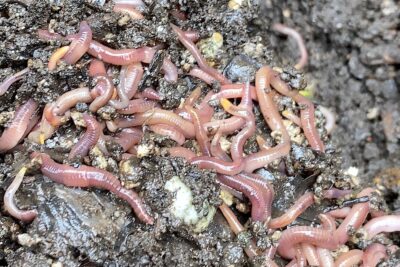
Now don't go dissing Walter, Wilma and the rest. They're my cleanest, hardest-working garden helpers.
Must you buy worms?
Not if you have a friend willing to share hers. Even a handful will do. Wigglers quickly reproduce.
Which reminds me, decades ago, red worms found my pile all on their own. Maybe angels dropped them.
Anything else to watch for?
Trees and shrubs love being near a compost pile. When a mat of fine white roots encroaches, chop them off...and, well, compost them.
Mr. Compost, your garden, and the taxpayers of California thank you.
Related Info on this site
Soil and Amendments for Succulents
Soil & Amendments for Succulents Why pumice is the ideal soil amendment for succulents Debra’s Simple Soil Formula for Succulents Please don’t stress over soil. I’ve seen succulents thriving in pots filled with garden soil so hard a ball would bounce on it, and at a nursery in soil so rich in peat that moss…
See Debra’s Idea-Filled Garden
Welcome to my site’s “Debra’s Garden” page. This is where you’ll find photos of plants in my half-acre succulent garden, as shown in my recently released, 15-min. video:” See My Idea-Filled Succulent Spring Garden.” The video came about as a result of my garden looking amazingly beautiful after a rainy April here

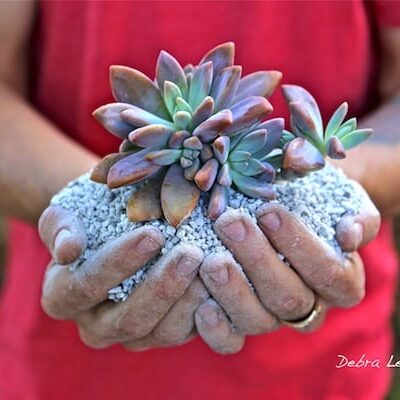

As a Master Gardener, I too learned to use alfalfa pellets in the garden. But since the ones made for livestock have molasses in them, the critters ( skunks, rats,raccoons, etc) love to come and eat them. So, the alfalfa pellets sold at nurseries are a better idea if you have wild critters in your area.
Hi Pamela — Good to know, thanks. I buy mine at an agricultural supplier, not a tack-and-feed store. As far as I know there’s nothing sweet added, but you can be sure I’ll check.
Excellent tutorial, Debra! Thank you! We had built a compost bin out of a recycled rain barrel but, just as you noted, it was a pain to manage and we ended up abandoning it and feeling guilty. This seems like a much more manageable method!
Hey Leslie, thank you! How cool to hear from a plant lady in Florida. You have the most gorgeous website! Wishing you lombrices felices (happy worms).
Love the idea of this method! How long do you find it takes for a pail of scraps to turn into compost that would be usable in a vegetable garden?
Hi Lauren — There are numerous factors: the time of year (warmer seasons tend to be quicker, up to a point), how large the scraps are (small is faster; large and dense are slower); how wet the pile is (it should be moist so worms can move easily); and how many worms there are. In my own pile, a pail of kitchen scraps gets broken down in fewer than two weeks, on average.